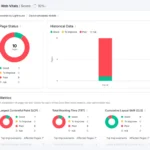
Introduction
In today’s competitive digital landscape, SEO for SaaS companies isn’t just about ranking for keywords — it’s about scaling sustainable growth.
Unlike e-commerce or local businesses, SaaS brands rely on recurring revenue, long buyer journeys, and educational content to attract, convert, and retain customers.
With the rise of AI-driven search and increased competition, SaaS companies in 2025 need a refined SEO strategy that combines technical precision, data-driven content, and long-term brand authority.
Let’s break down the proven SaaS SEO strategies that scale and help you dominate organic search.
1. Understanding the SaaS SEO Landscape
SaaS (Software-as-a-Service) products face a unique SEO challenge — most keywords are competitive, solution-focused, and intent-driven.
Buyers don’t search for your brand name initially — they search for problems:
“best project management tools for teams”
“CRM software for small businesses”
That’s why your SEO strategy should align with each stage of the SaaS funnel:
- Top of Funnel (TOFU): Educational blogs, comparisons, guides
- Middle of Funnel (MOFU): Case studies, solution pages, webinars
- Bottom of Funnel (BOFU): Product demos, pricing, testimonials
By targeting user intent at every stage, you create an ecosystem that builds trust and drives conversions.
2. Keyword Research for SaaS Companies
Keyword strategy in SaaS SEO must go beyond high-volume terms. The focus should be on search intent and problem-solution fit.
Types of SaaS Keywords
- Problem-Based Keywords:
- “how to track customer churn”
- “ways to improve team collaboration”
- Comparison Keywords:
- “HubSpot vs Salesforce”
- “best email marketing tools 2025”
- Feature Keywords:
- “AI analytics dashboard”
- “cloud project management software”
- Branded Keywords:
- “Notion templates”
- “Asana pricing”
Use tools like Ahrefs, SEMrush, or Google Keyword Planner to find search intent clusters and build topic authority.
💡 Pro Tip: Create keyword clusters around core features — for example, if your SaaS tool focuses on “workflow automation,” you can build related topics like “automation software for agencies” or “workflow management best practices.”
3. SaaS Content Marketing: Educate, Don’t Just Sell
Content is the cornerstone of SaaS SEO — but the goal isn’t just to rank; it’s to educate and convert.
Content Types That Work Best
- In-depth blog posts explaining industry problems
- Product-led tutorials (e.g., “How to automate onboarding with [Your SaaS Tool]”)
- Comparison and alternative pages (“Best alternatives to [Competitor]”)
- Use-case landing pages targeting specific industries or teams
- Customer success stories that build credibility
Combine educational content with subtle product integration to guide readers through the funnel.
Example: Instead of writing “Why Workflow Software Is Important”, write “How to Automate Workflow Using [Your SaaS Tool]” — this drives both awareness and product adoption.
4. On-Page SEO for SaaS Websites
Optimizing your SaaS website is essential to convert traffic into sign-ups or demos.
Best Practices:
- Use clear, benefit-focused headlines (“Save 10 Hours Weekly with Smart Automation”).
- Implement structured data for FAQs, reviews, and products.
- Optimize meta titles and descriptions with value-driven CTAs.
- Add internal links between blog posts, feature pages, and demo sign-ups.
- Ensure fast page loading and mobile responsiveness.
Google now rewards page experience metrics (Core Web Vitals), so invest in speed, usability, and trust signals like HTTPS, testimonials, and transparent pricing.
5. Building Authority Through Backlinks
Backlinks remain a strong ranking factor, especially for SaaS companies in competitive niches.
Effective SaaS Link-Building Tactics:
- Guest Posting: Publish insights on niche SaaS or marketing blogs.
- Digital PR: Share data-driven reports or research findings.
- Partnerships: Collaborate with integration partners or influencers.
- Resource Pages: Get listed on “Top Tools” or “Best Software” lists.
- Broken Link Outreach: Offer your resource as a replacement for outdated links.
The goal isn’t quantity — it’s quality and relevance. One backlink from a trusted SaaS or tech publication is worth more than ten from generic blogs.
6. Product-Led SEO: Turn Features Into Content
Product-led SEO is the emerging trend for SaaS growth. Instead of generic blogs, you create SEO content that directly connects user problems with your product features.
Example:
If your SaaS tool helps with “email deliverability,” create articles like:
- “How to Improve Email Deliverability (Using [Your Tool])”
- “5 Deliverability Mistakes Marketers Make — and How to Fix Them”
This approach builds both organic visibility and product awareness, turning every blog reader into a potential trial user.
7. Optimize for AI and Search Generative Experience (SGE)
Google’s AI Overviews and Search Generative Experience are changing how SaaS companies appear in search.
To adapt:
- Write conversational content that answers specific queries.
- Use structured data and FAQ sections for better AI understanding.
- Maintain a consistent brand voice and expert author profiles for E-E-A-T signals.
- Ensure your SaaS product descriptions and knowledge base are semantically optimized for entities (people, tools, features).
AI-driven search favors context-rich, factual, and trustworthy content.
8. Measuring and Scaling SaaS SEO
Unlike short-term campaigns, SEO compounds over time. To scale it effectively, track KPIs that reflect user intent and growth, not just traffic.
Key SaaS SEO Metrics
- Organic traffic and sign-ups
- Demo or trial conversion rate
- Keyword rankings for BOFU pages
- Backlink quality and domain authority
- Customer lifetime value (CLV) from organic sources
Use analytics tools like Google Search Console, GA4, and Ahrefs to continuously optimize your strategy.
FAQs
1. Why is SEO important for SaaS companies?
Because it builds long-term visibility and organic acquisition, reducing dependency on paid ads and improving lead quality.
2. How long does it take for SaaS SEO to show results?
Typically 4–6 months, depending on competition, domain authority, and content quality. SaaS SEO is a long-term investment with compounding growth.
3. What’s the biggest SEO challenge for SaaS brands?
High competition for generic keywords and long buyer journeys. That’s why intent-driven, product-led, and educational content is essential.
4. How can SaaS companies build backlinks effectively?
By publishing high-quality, original content like case studies, reports, and guides that attract natural backlinks and PR mentions.
5. Does AI affect SaaS SEO?
Yes — AI tools and Google’s AI Overviews now emphasize semantic understanding, E-E-A-T, and structured data. Adapting your content to AI-driven search helps maintain visibility.
Conclusion
Scaling SEO for SaaS companies requires more than keyword rankings — it demands a full-funnel strategy combining educational content, product-led storytelling, and technical optimization.
By focusing on structured data, trust, and AI-ready content, SaaS brands can build sustainable organic visibility and customer growth in 2025 and beyond.
Start small, measure consistently, and let SEO become the foundation of your SaaS growth engine.
Visit our services – SEO services in Kanpur | SEO services in Surat | SEO company in Jaipur | SEO comapany in Lucknow| SEO company in Ameerpet





